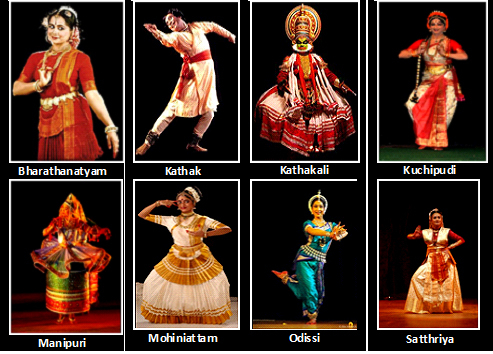Classical Dances Of India

| Dance | State | Famous Personalities |
| Bharatnatyam | Tamil nadu | Rukmani devi Arundale, Krisna murthy, Shovana Narayan Sonal Mansingh, Vaijayantimala, T Balakrishan, Padma Subramaniyam. |
| Kathak | Uttar Pradesh | Birju Maharaj, Shovana Narayan. |
| Kuchipudi | Andhra Pradesh | Mallika Sarabhai, Yamini Krishanmurthy, T Balasarswathi, Ragini Devi,G, sarala, Raja Reddy |
| Kathakali | Kerala | Mukunda Raja, Koppan Nair, Gopinath Karishan |
| Odissi | Odisha | Guuru Mayadhar Raut, Kelucharan Mohapatra |
| Manipuri | Manipur | Jhaver Sisters, Rita devi |
| Sattriya | Assam | Anwesa Mahanta |
| Mohiniyatta | Kerala | Kalyani Amma, Shanta Rao. |
Folk Dances
| State | Dance |
| Andhra Pradesh | Kuchipudi, Kolattam |
| Arunachal Pradesh | Bardo Chham |
| Assam | Bihu dance, Jhumur Naach |
| Jharkhand | Karma/Munda |
| Chhattisgarh | Panthi, Raut Nacha, Gaur Maria, Dekhni Dance |
| Goa | Koli, Dashavatara, Dekhni, Dhalo, Ghodemodni, Romta Mel, Divlyan Nach (Lamp dance) |
| Gujarat | Garba, Raas, Tippani Dance |
| Himachal Pradesh | Kinnauri Nati |
| Haryana | Saang, Ras Leela, Ghoomar, Jhumar, Teej, Phag ,Dhamal |
| Karnataka | Yakshagana, Bayalata. |
| Kerala | Mohiniyattam, Kathakali, Koodiyattam, Thirayattam, Thitambu Nritham, Aravanmuttu, Padayani. |
| Madhya Pradesh | Jawara, Maanch, Grida, Tertali, Phulpati Dance, Matki Dance |
| Maharashtra | Lavni, Tamasha ,Dangi ,Pavri Nach ,Povadas ,Koli ,Dindi |
| Manipur | Thang Ta, Dhol cholom |
| Mizoram | Cheraw Dance |
| Nagaland | Chang Lo or Sua Lua. |
| Odisha | Ghumura Dance, Ruk Mar Nacha (& Chhau dance), Goti Pua, Nacni, Odissi, Baagh Naach or Tiger Dance, Dalkhai , Dhap, Ghumra |
| Punjab | Bhangra, Giddh , Jhumar, Karthi, Ludi |
| Rajasthan | Ghoomar, Kalbelia, Bhavai, Kachchhi Ghodi. |
| Sikkim | Singhi Chham |
| Tamil Nadu | Bharatanatyam, Kamandi or Kaman Pandigai, Devarattam, Kummi, Kolattam, Karagattam or Karagam, Mayil Attam or Peacock dance Paampu attam or Snake Dance |
| Tripura | Hojagiri |
| West Bengal | Gambhira, Nacni, Alkap, Domni, Chow |
Gharanas
| NAME | PLACE | FOUNDER |
| Gwalior | Gwalior | Nanthan Khan |
| Agra | Agra | Hajisujan Khan |
| Rangeela | Agra | Faiyyaz Khan |
| Jaipur Atroli | Jaipur | Alladiya Khan |
| Kiran | Avadh | Abdul wahid khan |
Comments
Post a Comment